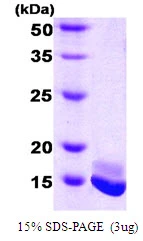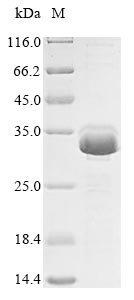
3microg Human Calmodulin protein (GTX67262-pro) by SDS-PAGE under reducing condition and visualized by coomassie blue stain.
Human Calmodulin protein
GTX67262-PRO
Protein IDP0DP23
Product group Proteins / Signaling Molecules
Overview
- SupplierGeneTex
- Product NameHuman Calmodulin protein
- Delivery Days Customer9
- CertificationResearch Use Only
- Concentration1 mg/ml
- ConjugateUnconjugated
- Protein IDP0DP23
- Protein NameCalmodulin-1
- Scientific DescriptionThis gene is a member of the calmodulin gene family. There are three distinct calmodulin genes dispersed throughout the genome that encode the identical protein, but differ at the nucleotide level. Calmodulin is a calcium binding protein that plays a role in signaling pathways, cell cycle progression and proliferation. Several infants with severe forms of long-QT syndrome (LQTS) who displayed life-threatening ventricular arrhythmias together with delayed neurodevelopment and epilepsy were found to have mutations in either this gene or another member of the calmodulin gene family (PMID:23388215). Mutations in this gene have also been identified in patients with less severe forms of LQTS (PMID:24917665), while mutations in another calmodulin gene family member have been associated with catecholaminergic polymorphic ventricular tachycardia (CPVT)(PMID:23040497), a rare disorder thought to be the cause of a significant fraction of sudden cardiac deaths in young individuals. Pseudogenes of this gene are found on chromosomes 10, 13, and 17. Alternative splicing results in multiple transcript variants encoding different isoforms. [provided by RefSeq, Mar 2015]
- Storage Instruction-20°C or -80°C,2°C to 8°C
- UNSPSC12352202

